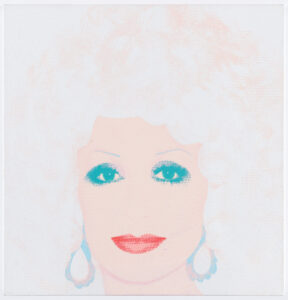Andy Warhol
American
1928, Pittsburgh, Pennsylvania
1987, New York, New York

An iconic figure in twentieth-century art and culture, Andy Warhol was born Andrew Warhola, the son of working-class immigrants from Slovakia. He studied commercial art in Pittsburgh before moving to New York in 1949 and beginning a highly successful career as an advertising illustrator.
A decade later Warhol started making paintings (at first handmade, later silkscreened) of images lifted directly from the mass media. His range included consumer products (Campbell's soup cans) and movie stars (Marilyn Monroe, Elvis Presley), as well as darker aspects of American culture, including race riots, car crashes, and the electric chair.
Warhol's inexpressive painting style was mirrored by his famously flat, monotone persona. An obsession with Hollywood glamour inspired a series of experimental films, often campy in tone and explicitly homoerotic. Warhol's Factory — a term for both his studio and the associated network of actors, musicians, druggies, and hangers-on — has become synonymous with 1960s bohemia. Although his work was initially controversial for its apparent non-art status, he quickly achieved both critical and commercial success.
In the 1970s and 1980s, Warhol's celebrity arguably eclipsed his art, although he produced several innovative bodies of work during this period. He died in 1987 from complications following a routine gallbladder surgery.
Audio Stories
Filmmaker Marc Huestis on Warhol’s obsession with celebrity
transcripts
Works in the Collection
-
 Andy WarholTelephone [1l]
Andy WarholTelephone [1l] -
 Andy WarholUntitled
Andy WarholUntitled -
 Andy WarholDog Food Cans
Andy WarholDog Food Cans -
 Andy WarholDolly Parton
Andy WarholDolly Parton -
 Andy WarholPuma Invader
Andy WarholPuma Invader -
 Andy WarholDrills 7.88
Andy WarholDrills 7.88 -
 Andy WarholBefore and After [3]
Andy WarholBefore and After [3] -
 Andy WarholJoseph Beuys [Camouflage]
Andy WarholJoseph Beuys [Camouflage] -
 Andy WarholSelf-Portrait
Andy WarholSelf-Portrait -
 Andy WarholMao
Andy WarholMao -
 Andy WarholRobert Mapplethorpe
Andy WarholRobert Mapplethorpe -
 Andy WarholTunafish Disaster
Andy WarholTunafish Disaster -
 Andy WarholMost Wanted Men No. 12, Frank B.
Andy WarholMost Wanted Men No. 12, Frank B. -
 Andy WarholTriple Elvis [Ferus type]
Andy WarholTriple Elvis [Ferus type] -
 Andy WarholDolly Parton
Andy WarholDolly Parton -
 Andy WarholSilver Marlon
Andy WarholSilver Marlon -
 Andy WarholSelf-Portrait [Camouflage]
Andy WarholSelf-Portrait [Camouflage] -
 Andy WarholMost Wanted Men No. 4, Redmond C.
Andy WarholMost Wanted Men No. 4, Redmond C. -
 Andy WarholJackie Triptych
Andy WarholJackie Triptych -
 Andy WarholNine Marilyns [Reversal series]
Andy WarholNine Marilyns [Reversal series]
Please note that artwork locations are subject to change, and not all works are on view at all times.
Only a portion of SFMOMA's collection is currently online, and the information presented here is subject to revision. Please contact us at collections@sfmoma.org to verify collection holdings and artwork information. If you are interested in receiving a high resolution image of an artwork for educational, scholarly, or publication purposes, please contact us at copyright@sfmoma.org.
This resource is for educational use and its contents may not be reproduced without permission. Please review our Terms of Use for more information.